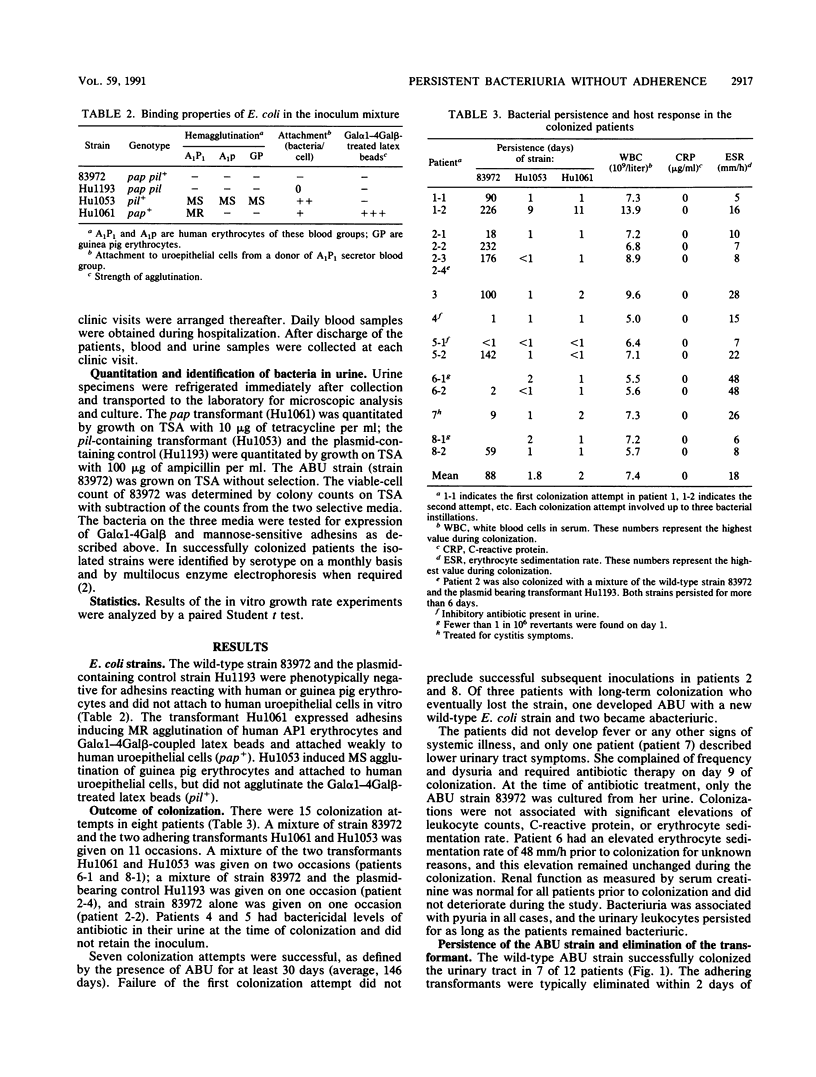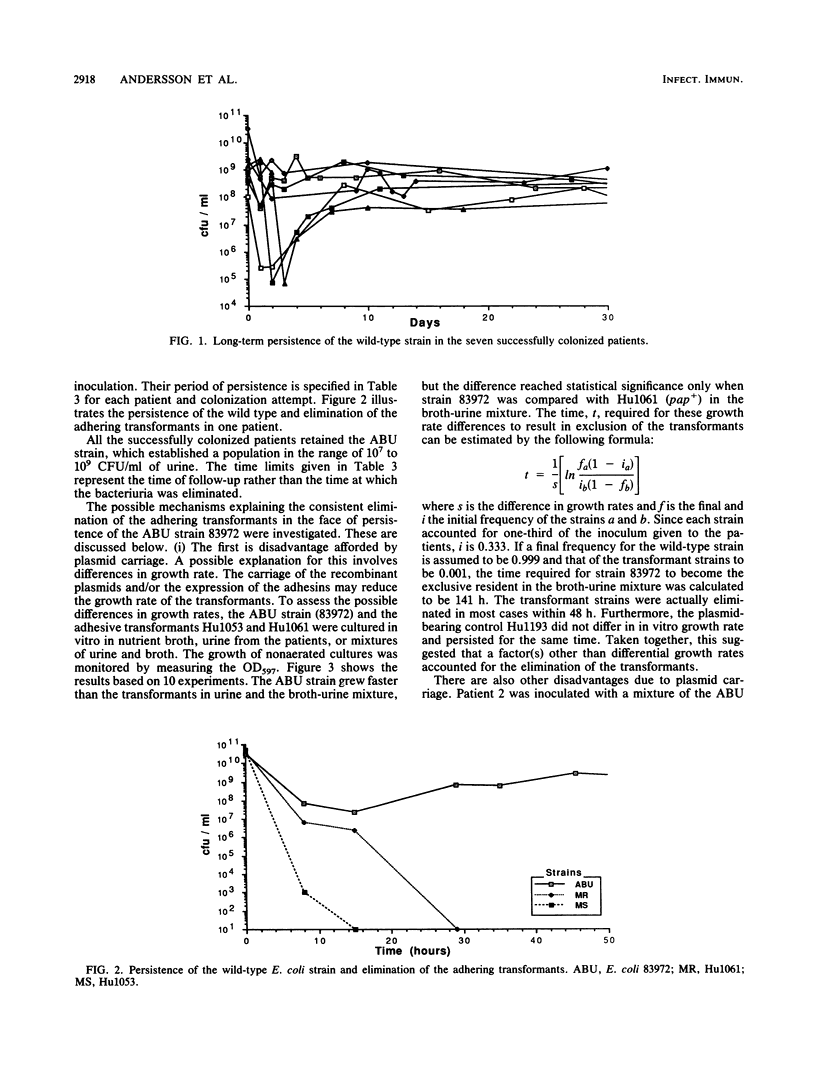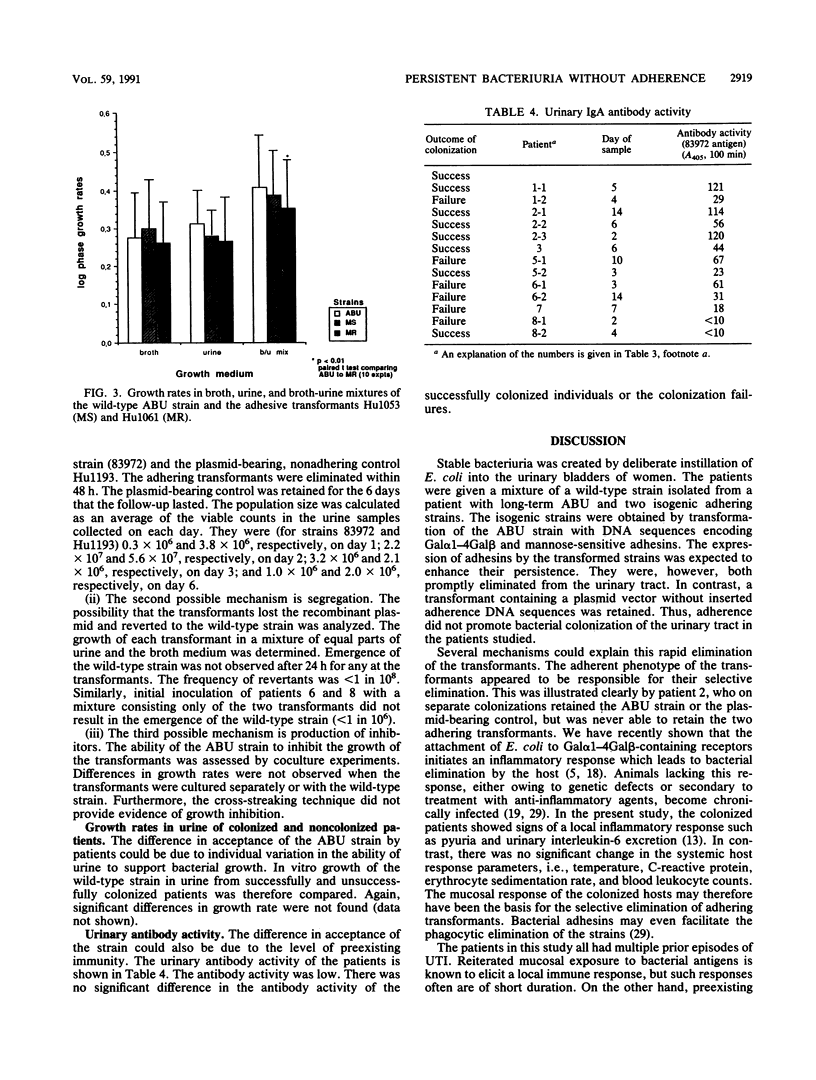Abstract
The role of bacterial adherence in the persistence of bacteria in the human urinary tract was analyzed. Women with chronic symptomatic urinary tract infections were subjected to deliberate colonization with nonvirulent Escherichia coli, after eradication of their current infections. E. coli organisms were instilled into the bladder through a catheter. The strain used for colonization, E. coli 83972, was isolated from a patient with stable bacteriuria. It lacked expressed adherence factors and did not belong to the uropathogenic O:K:H serotypes. Strain 83972 was transformed with the pap and pil DNA sequences encoding Gal alpha 1-4Gal beta- and mannose-specific (type 1) adhesins. Patients were colonized with a mixture of the wild-type and the transformed strains. E. coli 83972 caused stable bacteriuria for greater than 30 days in 7 of 12 individuals. In contrast, the Gal alpha 1-4 Gal beta-recognizing or mannose-binding transformants were eliminated within 48 h. The consistent superiority of the wild-type strain in establishing stable bacteriuria when compared with the adhesive transformants did not appear to be due to differences in growth rates or to plasmid segregation. Rather, the transformants expressing the adhesin determinants were selectively eliminated by the host. This suggested that the acquisition of adherence factors is not sufficient to increase the fitness of E. coli for survival in the urinary tract of humans.
Full text
PDF






Selected References
These references are in PubMed. This may not be the complete list of references from this article.
- Akerlund A. S., Ahlstedt S., Hanson L. A., Jodal U. Antibody responses in urine and serum against Escherichia coli O antigen in childhood urinary tract infection. Acta Pathol Microbiol Scand C. 1979 Feb;87C(1):29–36. [PubMed] [Google Scholar]
- Bloch C. A., Orndorff P. E. Impaired colonization by and full invasiveness of Escherichia coli K1 bearing a site-directed mutation in the type 1 pilin gene. Infect Immun. 1990 Jan;58(1):275–278. doi: 10.1128/iai.58.1.275-278.1990. [DOI] [PMC free article] [PubMed] [Google Scholar]
- Caugant D. A., Levin B. R., Orskov I., Orskov F., Svanborg Eden C., Selander R. K. Genetic diversity in relation to serotype in Escherichia coli. Infect Immun. 1985 Aug;49(2):407–413. doi: 10.1128/iai.49.2.407-413.1985. [DOI] [PMC free article] [PubMed] [Google Scholar]
- Eden C. S., Eriksson B., Hanson L. A. Adhesion of Escherichia coli to human uroepithelial cells in vitro. Infect Immun. 1977 Dec;18(3):767–774. doi: 10.1128/iai.18.3.767-774.1977. [DOI] [PMC free article] [PubMed] [Google Scholar]
- Edén C. S., Freter R., Hagberg L., Hull R., Hull S., Leffler H., Schoolnik G. Inhibition of experimental ascending urinary tract infection by an epithelial cell-surface receptor analogue. Nature. 1982 Aug 5;298(5874):560–562. doi: 10.1038/298560a0. [DOI] [PubMed] [Google Scholar]
- Firon N., Ofek I., Sharon N. Interaction of mannose-containing oligosaccharides with the fimbrial lectin of Escherichia coli. Biochem Biophys Res Commun. 1982 Apr 29;105(4):1426–1432. doi: 10.1016/0006-291x(82)90947-0. [DOI] [PubMed] [Google Scholar]
- Hagberg L., Hull R., Hull S., Falkow S., Freter R., Svanborg Edén C. Contribution of adhesion to bacterial persistence in the mouse urinary tract. Infect Immun. 1983 Apr;40(1):265–272. doi: 10.1128/iai.40.1.265-272.1983. [DOI] [PMC free article] [PubMed] [Google Scholar]
- Hansson S., Caugant D., Jodal U., Svanborg-Edén C. Untreated asymptomatic bacteriuria in girls: I--Stability of urinary isolates. BMJ. 1989 Apr 1;298(6677):853–855. doi: 10.1136/bmj.298.6677.853. [DOI] [PMC free article] [PubMed] [Google Scholar]
- Hansson S., Jodal U., Norén L., Bjure J. Untreated bacteriuria in asymptomatic girls with renal scarring. Pediatrics. 1989 Dec;84(6):964–968. [PubMed] [Google Scholar]
- Hedges S., Anderson P., Lidin-Janson G., de Man P., Svanborg C. Interleukin-6 response to deliberate colonization of the human urinary tract with gram-negative bacteria. Infect Immun. 1991 Jan;59(1):421–427. doi: 10.1128/iai.59.1.421-427.1991. [DOI] [PMC free article] [PubMed] [Google Scholar]
- Hull R. A., Gill R. E., Hsu P., Minshew B. H., Falkow S. Construction and expression of recombinant plasmids encoding type 1 or D-mannose-resistant pili from a urinary tract infection Escherichia coli isolate. Infect Immun. 1981 Sep;33(3):933–938. doi: 10.1128/iai.33.3.933-938.1981. [DOI] [PMC free article] [PubMed] [Google Scholar]
- Hull S., Clegg S., Sanborg Eden C., Hull R. Multiple forms of genes in pyelonephritogenic Escherichia coli encoding adhesins binding globoseries glycolipid receptors. Infect Immun. 1985 Jan;47(1):80–83. doi: 10.1128/iai.47.1.80-83.1985. [DOI] [PMC free article] [PubMed] [Google Scholar]
- Linder H., Engberg I., Baltzer I. M., Jann K., Svanborg-Edén C. Induction of inflammation by Escherichia coli on the mucosal level: requirement for adherence and endotoxin. Infect Immun. 1988 May;56(5):1309–1313. doi: 10.1128/iai.56.5.1309-1313.1988. [DOI] [PMC free article] [PubMed] [Google Scholar]
- O'Hanley P., Lark D., Falkow S., Schoolnik G. Molecular basis of Escherichia coli colonization of the upper urinary tract in BALB/c mice. Gal-Gal pili immunization prevents Escherichia coli pyelonephritis in the BALB/c mouse model of human pyelonephritis. J Clin Invest. 1985 Feb;75(2):347–360. doi: 10.1172/JCI111707. [DOI] [PMC free article] [PubMed] [Google Scholar]
- Orskov I., Orskov F. Serology of Escherichia coli fimbriae. Prog Allergy. 1983;33:80–105. [PubMed] [Google Scholar]
- Plos K., Carter T., Hull S., Hull R., Svanborg Edén C. Frequency and organization of pap homologous DNA in relation to clinical origin of uropathogenic Escherichia coli. J Infect Dis. 1990 Mar;161(3):518–524. doi: 10.1093/infdis/161.3.518. [DOI] [PubMed] [Google Scholar]
- Roberts J. A., Kaack B., Källenius G., Möllby R., Winberg J., Svenson S. B. Receptors for pyelonephritogenic Escherichia coli in primates. J Urol. 1984 Jan;131(1):163–168. doi: 10.1016/s0022-5347(17)50251-7. [DOI] [PubMed] [Google Scholar]
- Seaton A. Control of substances hazardous to health. BMJ. 1989 Apr 1;298(6677):846–847. doi: 10.1136/bmj.298.6677.846. [DOI] [PMC free article] [PubMed] [Google Scholar]
- Svanborg Edén C., Hausson S., Jodal U., Lidin-Janson G., Lincoln K., Linder H., Lomberg H., de Man P., Mårild S., Martinell J. Host-parasite interaction in the urinary tract. J Infect Dis. 1988 Mar;157(3):421–426. doi: 10.1093/infdis/157.3.421. [DOI] [PubMed] [Google Scholar]
- Svanborg-Edén C., Hagberg L., Hull R., Hull S., Magnusson K. E., Ohman L. Bacterial virulence versus host resistance in the urinary tracts of mice. Infect Immun. 1987 May;55(5):1224–1232. doi: 10.1128/iai.55.5.1224-1232.1987. [DOI] [PMC free article] [PubMed] [Google Scholar]
- Tencer J. Asymptomatic bacteriuria--a long-term study. Scand J Urol Nephrol. 1988;22(1):31–34. doi: 10.1080/00365599.1988.11690380. [DOI] [PubMed] [Google Scholar]
- Wold A. E., Mestecky J., Tomana M., Kobata A., Ohbayashi H., Endo T., Edén C. S. Secretory immunoglobulin A carries oligosaccharide receptors for Escherichia coli type 1 fimbrial lectin. Infect Immun. 1990 Sep;58(9):3073–3077. doi: 10.1128/iai.58.9.3073-3077.1990. [DOI] [PMC free article] [PubMed] [Google Scholar]
- Wold A. E., Thorssén M., Hull S., Edén C. S. Attachment of Escherichia coli via mannose- or Gal alpha 1----4Gal beta-containing receptors to human colonic epithelial cells. Infect Immun. 1988 Oct;56(10):2531–2537. doi: 10.1128/iai.56.10.2531-2537.1988. [DOI] [PMC free article] [PubMed] [Google Scholar]
- de Man P., Cedergren B., Enerbäck S., Larsson A. C., Leffler H., Lundell A. L., Nilsson B., Svanborg-Edén C. Receptor-specific agglutination tests for detection of bacteria that bind globoseries glycolipids. J Clin Microbiol. 1987 Feb;25(2):401–406. doi: 10.1128/jcm.25.2.401-406.1987. [DOI] [PMC free article] [PubMed] [Google Scholar]
- de Man P., Jodal U., Lincoln K., Edén C. S. Bacterial attachment and inflammation in the urinary tract. J Infect Dis. 1988 Jul;158(1):29–35. doi: 10.1093/infdis/158.1.29. [DOI] [PubMed] [Google Scholar]


